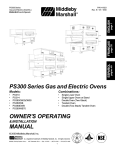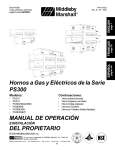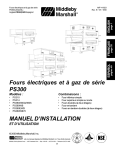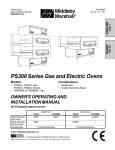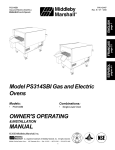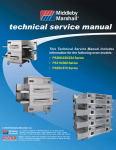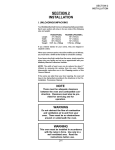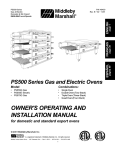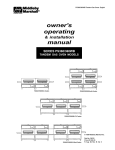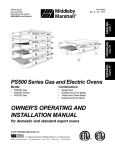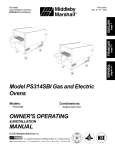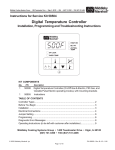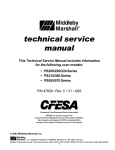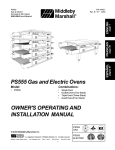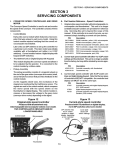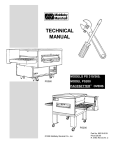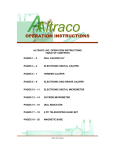Download Middleby Marshall PS360-U Installation manual
Transcript
P/N 41823
Rev. B V3 5/00
página 49
ESPAÑOL
page 25
FRANÇAIS
page 1
ENGLISH
PS300 Series
Gas and Electric (AGA/UL)
ENGLISH/French/Spanish
PS300 Series Gas and Electric Ovens
Models:
Combinations:
PS310
PS314
PS360/360Q/360S
PS360WB
PS360EWB
PS360WB70
Single Lower Oven
Single Upper Oven on Stand
Double Oven (Two-Stack)
Tandem Oven
Double (Two-Stack) Tandem Oven
OWNER'S OPERATING
& INSTALLATION
MANUAL
© 2000 Middleby Marshall, Inc.
is a registered trademark of Middleby Marshall, Inc. All rights reserved.
Middleby Cooking Systems Group 1400 Toastmaster Drive Elgin, IL 60120 (847)741-3300 FAX (847)741-4406
1
NOTICE:
This Owner's Operating and Installation Manual should be given to the user. The operator of the oven should
be familiar with the functions and operation of the oven.
This manual must be kept in a prominent, easily reachable location near the oven.
ENGLISH
Gas ovens are designed for use with EITHER natural gas OR liquid propane gas, as specified on the serial plate.
Where permitted by local and national codes, the oven can be converted from natural gas to propane operation,
or from propane to natural gas operation. This conversion requires the installation of the appropriate Middleby
Marshall Gas Conversion Kit by an Authorized Service Agent.
It is suggested to obtain a service contract with a Middleby Marshall Authorized Service Agent.
WARNING
POST, IN A PROMINENT LOCATION, THE EMERGENCY TELEPHONE NUMBER OF YOUR LOCAL GAS
SUPPLIER AND INSTRUCTIONS TO BE FOLLOWED IN THE EVENT YOU SMELL GAS.
Instructions to be followed in the event the user smells gas shall be obtained by consulting the local gas
supplier. If the smell of gas is detected, immediately call the emergency phone number of your local Gas
Company. They will have personnel and provisions available to correct the problem.
FOR YOUR SAFETY
Do not store or use gasoline or other flammable vapors or liquids in the vicinity of
this or any other appliance.
WARNING:
Improper installation, adjustment, alteration, service or maintenance
can cause property damage, injury or death. Read the installation,
operating and maintenance instructions thoroughly before installing
or servicing this equipment.
IMPORTANT
An electrical wiring diagram for the oven is located inside the machinery
compartment or control compartment.
IMPORTANT
It is the customer's responsibility to report any concealed or non-concealed damage
to the freight company. Retain all shipping materials until it is certain that the
equipment has not suffered concealed shipping damage.
NOTICE: CONTACT YOUR MIDDLEBY MARSHALL AUTHORIZED SERVICE AGENT TO PERFORM MAINTENANCE
AND REPAIRS. AN AUTHORIZED SERVICE AGENCY DIRECTORY IS SUPPLIED IN YOUR INSTALLATION KIT.
NOTICE: Using any parts other than genuine Middleby Marshall factory manufactured parts relieves the manufacturer of
all warranty and liability.
NOTICE: Middleby Marshall (Manufacturer) reserves the right to change specifications at any time.
NOTICE: The equipment warranty is not valid unless the oven is installed, started and demonstrated under the supervision
of a factory certified installer.
Retain This Manual For Future Reference
Middleby Cooking Systems Group 1400 Toastmaster Drive Elgin, IL 60120 USA (847)741-3300 FAX (847)741-4406
24-Hour Service Hotline: 1-(800)-238-8444
www.middleby.com
2
page
page
SECTION 1 - DESCRIPTION .................................................... 4
IV. THERMOCOUPLE INSTALLATION .......................... 9
I.
OVEN USES ............................................................. 4
V.
II.
OVEN COMPONENTS ............................................. 4
VI. CONVEYOR INSTALLATION ................................... 12
III.
A.
Crumb Pans ..................................................... 4
A.
All Non-Tandem Ovens ................................... 12
B.
Conveyor Drive Motor ........................................ 4
B.
Tandem Oven Models ..................................... 13
C.
Conveyor ........................................................... 4
VII. FINAL ASSEMBLY ................................................... 13
D.
End Plugs ......................................................... 4
VIII. ELECTRICAL SUPPLY ........................................... 14
E.
Serial Plate ........................................................ 4
A.
Electric Ovens .................................................. 14
F.
Window ............................................................. 4
B.
Gas Ovens ....................................................... 14
G.
Machinery Compartment Access Panel ........... 4
C.
Ovens with External Transformers .................. 14
H.
Control Compartment Access Panel ............... 4
D.
Connection ....................................................... 14
I.
Control Panel .................................................... 4
J.
Eyebrows .......................................................... 4
A.
Gas Utility Rough-In Recommedations .......... 15
K.
Conveyor End Stop ........................................... 4
B.
Connection ....................................................... 15
L.
Gas Burner ........................................................ 4
C.
Gas Conversion ............................................... 15
M.
Blowers ............................................................. 4
N.
Air Fingers ......................................................... 4
IX. GAS SUPPLY .......................................................... 15
SECTION 3 - OPERATION ...................................................... 16
OVEN SPECIFICATIONS ......................................... 4
I.
II.
III.
LOCATION AND DESCRIPTION OF CONTROLS .. 16
A.
Dimensions ...................................................... 4
A.
BLOWER (
B.
General Specifications ..................................... 5
B.
HEAT (
C.
Gas Orifice and Pressure Specifications ......... 5
C.
CONVEYOR (
D.
Electrical Specifications - Gas Ovens .............. 5
D. Conveyor Speed Controller ............................. 16
E.
Electrical Specifications - Electric Ovens ......... 5
E.
Digital Temperature Controller ........................ 16
F.
Machinery Cpt. Access Panel Safety Switch .... 16
SECTION 2 - INSTALLATION .................................................. 6
I.
TANDEM OVEN ASSEMBLY .................................... 10
II.
) Switch ...................................... 16
) Switch ............................................ 16
) Switch ............................... 16
NORMAL OPERATION, STEP-BY-STEP ................. 17
INSTALLATION KIT .................................................. 7
A.
Daily Startup Procedures ................................. 17
A.
Components ..................................................... 7
B.
Daily Shutdown Procedures ............................ 17
B.
Additional Components - Gas Ovens .............. 7
III. QUICK REFERENCE: DIGITAL TEMP CONTROL . 18
C.
Additional Components - Tandem Ovens ........ 7
IV. QUICK REFERENCE: TROUBLESHOOTING ........ 19
VENTILATION SYSTEM ............................................ 8
A.
Requirements ................................................... 8
SECTION 4 - MAINTENANCE ................................................. 20
B.
Recommendations ........................................... 8
I.
MAINTENANCE - DAILY .......................................... 21
C.
Other Ventilation Concerns .............................. 8
II.
MAINTENANCE - MONTHLY ................................... 22
ASSEMBLY ............................................................... 9
III. MAINTENANCE - EVERY 3 MONTHS ..................... 23
A.
Stacking ............................................................ 9
IV. MAINTENANCE - EVERY 6 MONTHS ..................... 23
B.
Stands ............................................................... 9
V.
3
KEY SPARE PARTS KIT .......................................... 24
ENGLISH
TABLE OF CONTENTS
SECTION 1 - DESCRIPTION
I.
OVEN USES
K.
PS300 Series Ovens can be used to bake and/or cook a
wide variety of food products, such as pizza, pizza-type
products, cookies, sandwiches and others.
Not Shown:
ENGLISH
L.
II. OVEN COMPONENTS - see Figure 1-1.
A.
Conveyor Drive Motor: Moves the conveyor.
C.
Conveyor: Moves the food product through the oven.
D.
End Plugs: Allow access to the oven's interior.
E.
Serial Plate: Provides specifications for the oven that affect
installation and operation. Refer to Section 2, Installation,
for details.
F.
Window (on ovens so equipped): Allows the user to see
and access food products inside the baking chamber.
G.
Machinery Compartment Access Panel: Allows access to
the oven's interior components. No user-servicable parts
are located in the machinery compartment.
H.
N.
Control Panel: Location of the operating controls for the
oven. Refer to Section 3, Operation, for details.
J.
Eyebrows (on ovens so equipped): Can be adjusted to
various heights to prevent heat loss into the environment.
Air Fingers: Project streams of hot air onto the food product.
Fig. 1-1 - Oven Components
B
C
E
D
F
H
A
Control Compartment Access Panel: Allows access to the
control components. This panel is combined with the
Machinery Compartment Access Panel on PS360EWB and
WB70 ovens. No user-servicable parts are located in the
control compartment.
I.
Gas Burner: Heats air, which is then projected to the air
fingers by the blowers.
M. Blowers: Fans that project hot air from the burner to the air
fingers.
Crumb Pans: Catch crumbs and other material that drop
through the conveyor belt. One crumb pan is located
underneath each end of the conveyor.
B.
Conveyor End Stop: Prevents food products from falling off
the end of the moving conveyor.
G
J
I
K
III. OVEN SPECIFICATIONS
A. Dimensions
PS310
PS314
Overall Height
Lower oven,
with top & legs
Upper oven,
with stand and top
Double oven
(two-stack)
PS360/360Q/360S PS360Tandem
45-1/2
1143mm
64-1/2"
1638mm
82-1/4
2089mm
45-1/2
1143mm
64-1/2"
1638mm
82-1/4
2089mm
45-1/2
1143mm
64-1/2"
1638mm
82-1/4
2089mm
Overall Depth
inc. rear shrouds
and front window
inc. rear shrouds
(no window)
39
991mm
36"
914mm
39
991mm
36"
914mm
47"
1194mm
44"
1118mm
PS360WB
PS360WBTandem
PS360EWB
PS360WB70
45-1/2
1143mm
64-1/2"
1638mm
82-1/4
2089mm
45-1/2
1143mm
64-1/2"
1638mm
82-1/4
2089mm
45-1/2
1143mm
64-1/2"
1638mm
82-1/4
2089mm
45-1/2
1143mm
64-1/2"
1638mm
82-1/4
2089mm
45-1/2
1143mm
64-1/2"
1638mm
82-1/4
2089mm
47"
1194mm
44"
1118mm
55"
1397mm
52"
1321mm
55"
1397mm
52"
1321mm
60"
1524mm
---
55"
1397mm
---
90-1/2"
2299mm
144-1/2"
3670mm
90-1/2"
2299mm
106"
2692mm
Overall Length
90-1/2"
70-3/4" *
90-1/2" *
144-1/2"
2299mm
1797mm*
2299mm *
3670mm
* NOTE: The PS314 and PS360Q dimensions do NOT include the optional end trays.
Conveyor Width
Single Belt
Split Belt,
identical width
Split Belt,
unequal width
24"
610mm
--
24"
610mm
--
--
Recommended Minimum Clearances
Rear of oven (inc.
1"
rear shrouds) to wall
25mm
Conveyor extension
0"
to wall (both ends)
0mm
--
32"
813mm
2x15"
381mm
--
32"
813mm
2x15"
381mm
--
40"
1016mm
2x19"
483mm
1x13"/330mm
AND
1x26"/660mm
40"
1016mm
2x19"
483mm
1x13"/330mm
AND
1x26"/660mm
44"
1118mm
2x21"
533mm
1x14"/356mm
AND
1x28"/711mm
40"
1016mm
2x19"
483mm
1x13"/330mm
AND
1x26"/660mm
1"
25mm
0"
0mm
1"
25mm
0"
0mm
1"
25mm
0"
0mm
1"
25mm
0"
0mm
1"
25mm
0"
0mm
1"
25mm
0"
0mm
1"
25mm
0"
0mm
4
SECTION 1 - DESCRIPTION
Weight
PS310
1165 lbs./529kg
PS314
1165 lbs./529kg
PS360/360Q/360S
1285 lbs./583kg
PS360WB
1485 lbs./674kg
PS360EWB
1620 lbs./733kg
PS360WB70
1825 lbs./829kg
Shipping Weight
1241 lbs./563kg
1241 lbs./563kg
1360 lbs./617kg
1560 lbs./708kg
1695 lbs./767kg
1900 lbs./863kg
Shipping Carton Vol.
105 ft.3/2.98m3
105 ft.3/2.98m3
106 ft.3/3.00m3
129 ft.3/3.65m3
129 ft.3/3.65m3
164 ft.3/4.65m3
Rated Heat Input
Gas
Electric
135,000 BTU
34,020kcal,40kw/hr.
26kw/hr.
135,000 BTU
135,000 BTU
170,000 BTU
175,000 BTU
175,000 BTU
34,020kcal,40kw/hr. 34,020kcal, 40kw/hr. 42,840kcal, 50kw/hr. 44,100kcal, 52kw/hr. 44,100kcal, 52kw/hr.
26kw/hr.
26kw/hr.
----
Max.OperatingTemp.
< - - - - - - - - - - - - - - - - - - - - - - - - - - - - - - - - - - - - - - - - - 550°F/288°C - - - - - - - - - - - - - - - - - - - - - - - - - - - - - - - - - - - - - - - >
Air Blowers
<----------------
2 blowers at 1550 ft.3 (43.9m3)/min. at 1700 RPM, 0.88"/2.2cm water static pressure - - - - - - - - - - - - - - - >
Air Jet Velocity (avg.) < - - - - - - - - - - - - - - - - - - - - - - - - - - - - - - - - - - - - 2600 ft./min. (1320cm/sec.) - - - - - - - - - - - - - - - - - - - - - - - - - - - - - - - - - - >
Warmup Time
<----------------------------------------
15 minutes
------------------------------------->
C. Gas orifice and pressure specifications - for gas-fired ovens (per oven cavity)
Main Orifice I.D.
PS310
PS314
PS360/360Q/360S
PS360WB
PS360EWB
PS360WB70
Pilot
Orifice I.D.
Bypass
Orifice I.D.
Supply (inlet)
pressure
Natural Gas
0.219
5.56mm
0.219
5.56mm
0.219
5.56mm
0.250
6.35mm
0.250
6.35mm
0.250
6.35mm
0.028
0.71mm
0.065/#53 drill
1.65mm
6-12" W.C.
14.9-29.9mbar
3-1/2" W.C.
8.7mbar
Propane
0.134"
3.40mm
0.134"
3.40mm
0.134"
3.40mm
0.152"
3.86mm
0.165"
4.19mm
0.165"
4.19mm
0.018"
0.46mm
0.034"/#62 drill
0.86mm
11-14" W.C.
27.4-34.9mbar
10" W.C.
24.9mbar
*
Manifold
pressure
* NOTE: The PS360EWB gas oven does not use a bypass orifice.
D. Electrical specifications - for gas-fired ovens (per oven cavity)
PS310/314/360/360Q/
360S/360WB
PS360EWB/WB70
Main Blower
Voltage
Control
Circuit Voltage
Phase
Freq.
Current
Draw
Poles
208-240V
208-240V (export)
200-220V (export)
120V
120V (transformer)
120V (transformer)
1 Ph
1 Ph
1 Ph
60 Hz
50/60 Hz
50/60 Hz
10A
10A
10A
3 Pole
2 Pole
2 Pole
208-240V
120V conveyor speed
controller (transformer);
all other control cicuits
as per line (208-240V)
1 Ph
60 Hz
12A
2 Pole
Wires
4 Wire (2 hot, 1 neut, 1 gnd)
3 Wire (2 hot, 1 gnd)
3 Wire (2 hot, 1 gnd)
3 wire (2 hot, 1 gnd)
E. Electrical specifications - for electrically-heated ovens (per oven cavity)
Main Blower
Voltage
Control
Circuit Voltage
Phase
Freq.
Current
Draw
kW
Rating
208-240V
(with 3 Ph blower motors)
120V
3 Ph
60 Hz
67.3A at 208V
58.4A at 240V
26.0 kW at 208V
26.0 kW at 240V
4 Pole
5 Wire (3 hot, 1 neut, 1 gnd)
208-240V
(with 1 Ph blower motors)
120V
3 Ph
60 Hz
67.3A at 208V
58.4A at 240V
26.0 kW at 208V
26.0 kW at 240V
4 Pole
5 Wire (3 hot, 1 neut, 1 gnd)
200-220V (export)
120V (transfomer)
3 Ph
50/60 Hz
67.3A at 208V
53.5A at 220V
24.3 kW at 208V
20.4 kW at 220V
3 Pole
4 Wire (3 hot, 1 gnd)
240V (export)
120V (transformer)
3 Ph
50/60 Hz
58.4A
26.0 kW
3 Pole
4 Wire (3 hot, 1 gnd)
380V (export)
120V (transformer)
3 Ph
50/60 Hz
36.8A
24.3 kW
3 Pole
4 Wire (3 hot, 1 gnd)
400-416V (export)
120V (transfomer)
3 Ph
50/60 Hz
33.8A
24.3 kW
3 Pole
4 Wire (3 hot, 1 gnd)
480V
120V (transformer)
3 Ph
60 Hz
29.2A
26.0 kW
3 Pole
4 Wire (3 hot, 1 gnd)
IMPORTANT
Poles
Wires
Additional electrical information is provided on the oven's serial plate, and on the wiring diagram inside the machinery
compartment.
5
ENGLISH
B. General specifications (per oven cavity)
SECTION 2 - INSTALLATION
WARNING - After any conversions, readjustments, or service work on the oven:
ENGLISH
Perform a gas leak test.
Test for correct air supply, particularly to the burner blower.
Test for proper combustion and gas supply.
Check that the ventilation system is in operation.
WARNING
Keep the appliance area free and clear of combustibles.
WARNING
The oven must be installed on an even (level) non-flammable flooring and any adjacent walls must
be non-flammable. Recommended minimum clearances are specified in the Description section of
this Manual.
WARNING
Do not obstruct the flow of combustion and ventilation air to and from your oven. There must be no
obstructions around or underneath the oven. Constructional changes to the area where the oven is
installed shall not affect the air supply to the oven.
CAUTION
For additional installation information, refer to the following documents:
PS360 Pre-Installation Procedures Manual (Middleby Marshall P/N 88210-0024)
PS360 Installation Manual (Middleby Marshall P/N 88210-0025)
Or, contact your local Authorized Service Agent.
NOTE
There must be adequate clearance between the oven and combustible construction. Clearance
must also be provided for servicing and for proper operation.
NOTE
An electrical wiring diagram for the oven is located inside the machinery compartment or control
compartment.
NOTE
All aspects of the oven installation, including placement, utility connections, and ventilation requirements,
must conform with any applicable local, national, or international codes. These codes supercede the requirements and guidelines provided in this manual.
NOTE
In U.S.A., the oven installation must conform with local codes, or in the absence of local codes, with the
National Fuel Gas Code, ANSI Z223.1. The oven, when installed, must be electrically grounded in accordance with local codes, or in the absence of local codes, with the National Electrical Code (NEC), or ANSI/
NFPA70.
NOTE
In Canada, the oven installation must conform with local codes, or in the absence of local codes, with the
Natural Gas Installation Code, CAN/CGA-B149.1, or the Propane Gas Installation Code, CAN/CGA-B149.2,
as applicable. The oven, when installed, must be electrically grounded in accordance with local codes, or in
the absence of local codes, with the Canadian Electrical Code CSA, C22.2, as applicable.
NOTE
For Australian installation, the oven installation must conform with AGA Code, AG601, and with any requirements of the appropriate statutory authority.
6
SECTION 2 - INSTALLATION
I. INSTALLATION KIT
Fig. 2-1 - Installation Kit
5
6
4
8
3
1
ENGLISH
7
11
10
2
9
12
A.
Installation kit components (one kit required per cavity)
Item
Description
PartNumber
LowerOvenw/oTop LowerOvenw/Top
UpperOven
1
Legs, adjustable
22450-0028
4
4
--
2*
Caster, Swivel (with stud)
37115-0102
4*
4*
4*
3a
Conveyor End Stop - PS310/314
35000-1099
1
1
1
3b
Conveyor End Stop - PS360/360S
Single Belt
Split Belt
35000-1103
35509
1
2
1
2
1
2
3c
Conveyor End Stop - PS360Q
37000-0524
1
1
1
3c
Conveyor End Stop - PS360WB/WB70 (Single or Split Belt)
36526
1
1
1
3d
Conveyor End Stop - PS360EWB
Single Belt
Split Belt: 2x21"/533mm belts
Split Belt: 1x14"/356mm belt +
1x28"/711mm belt
35900-0370
35900-0370
35509
35000-1099
2
2
1
1
2
2
1
1
2
2
1
1
4
Attachment Plate, upper oven
35122-0049
--
--
2
5
Thermocouple
33812-1
2
2
2
6
Screw, #10-32 x 3/8"
21256-0008
2
2
2
7
Cable Clamp
27276-0001
1
1
1
8
Screw, #2PT 10-16 x 3/4" HWH
21292-0001
2
2
14
41823
1
1
1
1002040
1
1
1
9
Owner's Operating and Installation Manual
10
Authorized Service Agency Listing
NOTE
* The 4 swivel casters (Item 2) are pre-attached to each oven cavity for ease of movement during installation.
B.
Item
Additional installation kit components for gas ovens
Description
PartNumber
LowerOvenw/oTop LowerOvenw/Top
UpperOven
6
Screw, #10-32 x 3/8"
21256-0008
1
1
1
8
Screw, #2PT 10-16 x 3/4" HWH
21292-0001
2
2
2
11
Gas hose, flexible
22361-0001
1
1
1
12a
Flue vent, 14" (356mm)
30773
--
1
--
12b
Flue vent, 29-1/2" (749mm)
30759
--
--
1
12c
Flue vent, 50" (1270mm)
30758
1
--
--
C.
Item
Additional installation kit components for tandem ovens (not shown)
PartNumber
TandemOven
Double (2-stack) Tandem Oven
--
Description
Machinery Compartment Trim Strip
35000-1454
1
2
--
Front Gasket Spacer
35000-1456
2
4
--
Rear Gasket Spacer
35000-1457
2
4
--
Baking Chamber Gasket and Frame - PS360
37200-0013
1
2
--
Baking Chamber Gasket and Frame - PS360WB
32483
1
2
7
SECTION 2 - INSTALLATION
II. VENTILATION SYSTEM
B.
NOTE THAT THE HOOD DIMENSIONS SHOWN IN FIGURE 22 ARE RECOMMENDATIONS ONLY. LOCAL AND NATIONAL
CODES MUST BE FOLLOWED WHEN INSTALLING THE
VENTILATION SYSTEM. ANY APPLICABLE LOCAL AND
NATIONAL CODES SUPERSEDE THE RECOMMENDATIONS
SHOWN IN THIS MANUAL.
IMPORTANT
ENGLISH
Where national or local codes require the
installation of fire suppression equipment or other supplementary equipment,
DO NOT mount the equipment directly to
the oven.
MOUNTING SUCH EQUIPMENT ON
THE OVEN MAY:
VOID AGENCY CERTIFICATIONS
RESTRICT SERVICE ACCESS
LEAD TO INCREASED SERVICE
EXPENSES FOR THE OWNER
A.
The rate of air flow exhausted through the ventilation system may
vary depending on the oven configuration and hood design.
Consult the hood manufacturer or ventilation engineer for these
specifications.
To avoid a negative pressure condition in the kitchen area, return
air must be brought back to replenish the air that was exhausted.
A negative pressure in the kitchen can cause heat- related
problems to the oven components as if there were no ventilation
at all. The best method of supplying return air is through the
heating, ventilation and air conditioning (HVAC) system. Through
the HVAC system, the air can be temperature-controlled for
summer and winter. Return air can also be brought in directly
from outside the building, but detrimental effects can result from
extreme seasonal hot and cold temperatures from the outdoors.
Requirements
NOTE: Return air from the mechanically driven system must not
blow at the opening of the baking chamber. Poor oven baking
performance will result.
CAUTION
A mechanically driven ventilation system is REQUIRED for
gas oven installations.
A mechanically driven ventilation system is STRONGLY
RECOMMENDED for electric oven installations.
PROPER VENTILATION OF THE
RESPONSIBILITY OF THE OWNER.
OVEN
IS
Recommendations
THE
C.
Other ventilation concerns
Special locations, conditions, or problems may require the
services of a ventilation engineer or specialist.
Inadequate ventilation can inhibit oven performance.
It is recommended that the ventilation system and duct work
be checked at prevailing intervals as specified by the hood
manufacturer and/or HVAC engineer or specialist.
Fig. 2-2 - Ventilation System
2"/51mm
minimum
18"
458mm
18"
458mm
8
12"
305mm
3"
76mm
SECTION 2 - INSTALLATION
III. ASSEMBLY
A.
Figure 2-3 - Exploded View, Oven Stand
Stacking
1.
Remove the casters (pre-attached to each oven cavity) from
the upper ovens.
2.
Stack the oven cavities. If necessary, refer to the Installation
Manual for Model PS310/360 Ovens (Middleby P/N 882100025).
B.
Stands
ENGLISH
If the installation will include upper ovens mounted atop lower
ovens:
Attachment
plates inc. w/
upper oven
installation kit
If the installation includes ovens that are to be mounted on
stands:
Remove the casters (pre-attached to each oven cavity) and
install them on the stands as shown in Figure 2-3.
Assemble the ovens to the stands. An exploded view of the
stand is shown in Figure 2-3.
C.
Flue Vent(s)
Casters inc.
w/oven
For gas ovens, attach one flue vent to the rear wall of each oven
cavity. Use one #10-16 x 3/8" and two #10-32 x 3/4" screws for
each flue vent. These screws are provided in the Installation Kit.
Figure 2-4 - Thermocouple Installation Locations
Thermocouples
IV. THERMOCOUPLE INSTALLATION
1.
Install one thermocouple sensing bulb into each of the two
holes in the rear panel of the oven, as shown in Figure 2-4.
Fasten each thermocouple in place using one of the #1032 x 3/8" screws supplied in the Installation Kit.
2.
Thread BOTH sets of thermocouple leads through the
grommet and into the machinery compartment, as shown
in Figure 2-4.
3.
Remove the right-side access panel of the machinery
compartment.
4.
Thread the thermocouple leads through the side of the
machinery compartment as shown in Figure 2-5, and into
the electrical box (at the right-front of the machinery compartment).
5.
Connect BOTH sets of thermocouple leads to the temperature controller as shown in Figure 2-6. Note that the two
thermocouples are now tied together at the temperature
controller.
6.
Replace the right-side panel of the machinery compartment.
7.
Repeat Steps 1-6 for any other oven cavities in the installation.
Grommet-protected hole
Figure 2-5 - Placing the Thermocouple Leads
Figure 2-6 - Thermocouple Lead Connections
8=White=Positive
7=Red=Negative
R=No Connection
Ground=Shielded cable
9
SECTION 2 - INSTALLATION
V. TANDEM OVEN ASSEMBLY
NOTE
For non-tandem oven installations, skip ahead to Section VI,
Conveyor Installation.
ENGLISH
1.
Determine the proper position of the ovens by referring to
Figure 2-7. Then, move the ovens to their approximate final
locations.
2.
Check that the top and bottom air finger retaining screws are
present on all mating ends of the oven sections. See Figure
2-7. The screws prevent the air fingers from sliding in
between the oven sections.
3.
Remove the rear axial cooling fans that are adjacent to the
mating sides of the ovens. The fans may either be completely
disconnected, or left attached by their wiring as shown in
Figure 2-8.
Figure 2-7
Oven Positioning and Alignment
RIGHT OVEN
LEFT OVEN
Alignment
plate
Air finger
retaining
screws
Slot for
alignment
plate
Sealing gasket
assembly
(pre-mounted)
NOTE: The Sealing Gasket Assembly may
be pre-mounted to EITHER of the oven
cavities.
Figure 2-8 - Cooling Fan Removal
Mating surface of
ovens (shown
from lower rear)
Wiring is still
connected
10
SECTION 2 - INSTALLATION
Insert three of the supplied 1/2 x 5 bolts through the holes
in the frame of the right oven, pointing outward as shown in
Figure 2-9. Then, slide the spacers into place on the bolts.
Figure 2-9 - Bolts and Spacers
ENGLISH
4.
2-1/2" x 2-1/2"
(64x64mm)
spacers
2-1/2" x 8"
(64x203mm)
spacers
5.
Push the ovens together. Check that the mounting bolts,
alignment plate, and sealing gasket are all properly aligned.
See Figure 2-10.
6.
Tighten all of the attaching bolts. Check that the mating
edges of the ovens align properly. If gaps appear between
the tops of the ovens, it will be necessary to loosen the
connecting bolts and realign the ovens.
7.
Attach the front trim strip between the two ovens, as shown
in Figure 2-11.
8.
Replace the rear axial cooling fans. See Figure 2-8.
Figure 2-10 - Aligning the Sections
Figure 2-11 - Trim Strip Installation
Trim strip
11
SECTION 2 - INSTALLATION
VI. CONVEYOR INSTALLATION
Figure 2-12 - Removing the Conveyor Drive Sprocket
Refer to either Step A or Step B in this section, as appropriate,
to install the conveyor and belt.
A.
Installing the Conveyor - All ovens EXCEPT Tandem models
ENGLISH
NOTE
Split belt conveyors can only be installed from the end of the oven
with the drive motor.
Single-belt conveyor assemblies may be inserted into either
end of the oven. If it is to be installed from the end of the oven
without the drive motor, the drive sprocket assembly must be
removed.
To remove the drive sprocket (if necessary), loosen the set screw
on the conveyor collar as shown in Figure 2-12. Then, pull the
sprocket assembly straight out.
1.
Lift the conveyor and position it in the oven as shown in
Figure 2-13.
Figure 2-13 - Inserting the Conveyor
1
2.
Continue moving the conveyor into the oven until the frame
protrudes equally from each end of the oven (about 18"/
457mm).
3.
Check that the retainers located on the underside of the
conveyor frame rest firmly against the lower end plug, as
shown in Figure 2-14.
2
Retainers on both ends of
PS360EWB, drive side
only for all other ovens
When the conveyor is positioned properly, check for freedom of movement of the conveyor belt by pulling it for about
2-3 feet (60 to 90 cm) with your fingers. The conveyor must
move freely.
5.
If the drive sprocket was removed when installing the
conveyor, replace it at this time.
6.
Install the drive chain between the conveyor drive sprocket
and the motor sprocket. To install the chain, it will be
necessary to lift the drive end of the conveyor slightly. The
drive motor and sprocket are shown in Figure 2-12.
7.
Install the conveyor drive motor cover and tighten its hanger
screw (on the rear wall of the oven).
8.
Check the tension of the conveyor belt as shown in Figure
2-15. The belt should lift between 3-4" (75-100mm). DO
NOT OVERTIGHTEN THE CONVEYOR BELT.
3
Figure 2-14 - Conveyor retainers
NOTE:
PS360EWB ovens have a retainer bracket that extends the
full width of the conveyor frame on both ends of the frame.
All other ovens have retainer clips as shown in Figure 2-14,
located on the drive (left) side of the frame only.
4.
Loosen conveyor collar
set screw, then pull shaft
straight out
Figure 2-15 - Checking the conveyor tension
3-4"
(75-100mm)
vertical
deflection
Conveyor
tension
adjustment
screws (idler
end only)
NOTE:
If necessary, the belt tension can be adjusted by turning the
conveyor adjustment screws, located at the idler (right) end
of the conveyor. See Figure 2-15.
12
SECTION 2 - INSTALLATION
Installing the Conveyor and Belt - Tandem oven models
NOTE
For non-tandem oven installations, skip ahead to Section VII,
Final Assembly.
1.
Insert the conveyor frame into the oven as follows:
Figure 2-17 - Tandem Conveyor Installation
Hinged
end section
Slide one hinged conveyor frame section into each end of
the oven. The two sections butt against each other at the gap
between the two oven sections. See Figure 2-17.
IMPORTANT
Be sure that the drive section of the conveyor frame is at the
same end of the oven as the conveyor drive motor.
2.
Slide the conveyor belt through the support rods underneath
the frame, and thread it through the oven. Then, reach
through the oven window and pull the free end of the belt
through the oven so that it lies atop the conveyor frame.
Hinged
end section
Figure 2-18 - Conveyor and Inside Master Link Orientation
Direction
of travel
After the belt has been pulled through the oven, check the
following:
The conveyor belt links must be oriented as shown in
Figure 2-18.
The smooth side of the conveyor belt must face UP.
3.
Connect the inside master links. Check that the links are
oriented as shown in Figure 2-18.
4.
Connect the outside master links. Note that the outside
master links have right and left sides. The right-side master
link has an open hook facing you, as shown in Figure 2-19.
5.
Check for freedom of movement of the conveyor belt by
pulling it for about 2-3 feet (60 to 90 cm) with your fingers. The
conveyor must move freely.
6.
Check the tension of the conveyor belt as shown in Figure
2-15 (on the previous page). The belt should lift between 34" (75-100mm). DO NOT OVERTIGHTEN THE CONVEYOR
BELT. If necessary, the belt tension can be adjusted by
turning the conveyor adjustment screws, located at the idler
(right) end of the conveyor.
7.
LOOSELY attach the conveyor drive motor to the end wall of
the oven. Refer to Figure 2-12 (for ovens with standard
conveyor frames) or Figure 2-20 (for ovens with heavy-duty
conveyor frames).
8.
Assemble the conveyor drive chain in place on the motor and
conveyor drive sprockets.
9.
CORRECT
master link
position
Incorrect
master link
position
Figure 2-19 - Outside Master Figure 2-20 - Drive Motor for
Tandem Oven Heavy-Duty
Link Orientation
Conveyor Frame
Direction
of travel
Figure 2-21 - Crumb tray positions
Upper Oven
(Drive End)
Position the motor to adjust the deflection of the drive chain
to 3/4 (19mm). DO NOT OVERTIGHTEN THE DRIVE
CHAIN. Then, tighten the bolts to hold the motor in place.
Upper Oven
(Idler End)
VII. FINAL ASSEMBLY
1.
Assemble the end plugs and motor housing onto the oven.
These components are shown in Figure 1-1 (on Page 1).
2.
Slide the conveyor extensions over the ends of the conveyor
frame. Be sure that the extension with the drive sprocket
opening is placed on the drive end.
Lower Oven
NOTE
The PS360EWB oven does not use conveyor extensions.
3.
Refer to Figure 2-21 for the correct location of each crumb tray.
Then, install the crumb trays underneath the conveyor as
shown in Figure 2-22. First, place the inside edge of the tray
onto the bracket attached to the end plug. Then, swing the
outside edge of the tray up and into place.
4.
Press the end stop down over the edge of the conveyor
extension at the exit end of the oven. See Figure 2-22.
5.
After the oven is moved to its final location, adjust the bottom
section of the legs so that the oven is level and the casters
do not touch the floor.
13
Figure 2-22 - Crumb trays, extensions, and end stop
End stop
Crumb tray
Conveyor extension
Conveyor frame
ENGLISH
B.
SECTION 2 - INSTALLATION
VIII. ELECTRICAL SUPPLY (all ovens)
ENGLISH
CAUTION
Before connecting incoming power to the oven, measure the
voltage of each input leg to neutral. The expected voltage is
approximately 120V. ANY voltage reading exceeding 130V
indicates that the supply has a high leg. CONNECTING A
HIGH LEG TO THE OVEN VOIDS ALL OVEN WARRANTIES.
Connecting a high leg to the black lead of the oven can severely
damage the ovens electrical and electronic components.
WARNING
Authorized supplier personnel normally accomplish
the connections for the ventilation system, electric supply,
and gas supply, as arranged by the customer. Following these
connections, the factory-authorized installer can perform the
initial startup of the oven.
NOTE: The electric supply installation must satisfy the
requirements of the appropriate statutory authority, such as the
National Electrical Code (NEC), ANSI/NFPA70, (U.S.A.); the
Canadian Electrical Code, CSA C22.2; the Australian Code
AG601; or other applicable regulations.
CAUTION
DO NOT CONNECT BLACK WIRE TO HIGH LEG.
VOLTAGE OF THE BLACK AND WHITE WIRES MUST
BE NO HIGHER THAN 130 VAC.
NOTE: The electric supply connection must meet all national
and local electrical code requirements.
A.
Additional Information - Electric Ovens
For electric ovens, a 1-1/4" (32mm) dia. cutout in the back
wall of the machinery compartment provides access for the
electrical supply connections. Using flexible cables for the
electric power supply conductors requires a 1-1/4" (32mm)
strain-relief fitting (not furnished with the oven) to enable
safe access to the terminal block from which power is
distributed to the oven.
Check the oven serial plate before making any electric supply
connections. Electric supply connections must agree with data
on the oven serial plate. The location of the serial plate is shown
in Figure 2-23.
A fused disconnect switch or a main circuit breaker (customer
furnished) MUST be installed in the electric supply line for each
oven cavity. It is recommended that this switch/circuit breaker
have lockout/tagout capability.
B.
Additional Information - Gas Ovens
All gas oven electric supply connections are made via the
electrical junction box on the rear of the oven, shown in
Figure 2-24. The power lines then connect to the oven
circuits through the Machinery Compartment Access Panel
Safety Switch. This switch interrupts electric power to the
oven when the Machinery Compartment Access Panel is
opened.
The supply conductors must be of the size and material (copper)
recommended. Refer to the wiring diagram inside the machinery compartment or control compartment of the oven. Electrical
specifications are also listed on the oven's serial plate (Figure
2-23) and in the Electrical Specifications table (on Page 5).
The oven requires a ground connection to the oven ground screw
located in the electrical junction box. (The box is shown in Figure
2-24.) If necessary, have the electrician supply the ground wire.
Do NOT use the wiring conduit or other piping for ground
connections!
C.
Additional Information - Ovens with External Transformers (export versions)
Position the transformer on the rear wall of the oven, on the
same side as the control compartment, as space permits.
Fasten it in place using the supplied mounting hardware.
Figure 2-23 - Oven Serial Plate
D.
Connection
Refer to the wiring diagram inside the machinery
compartment or control compartment of the oven to
determine the correct connections for the electrical supply
lines. Connect the supply as indicated on the wiring
diagram. Be sure to connect the electrical supply ground
wire to the oven ground screw located in the junction box
on the rear of the oven.
Serial plate location
Figure 2-25 - Flexible Gas
Hose Installation
Figure 2-24 - Utility Connection Locations
Electrical
Junction Box
To Gas
Supply Pipe
Appliance
Connection/Male
Nipple
Gas oven:
3/4" (19mm) pipe for
gas utility connection
90°
Elbow
Electric oven:
1-1/2" (38mm) conduit for
electric utility connection
NOTE: The location of these
components may vary slightly
depending on the oven model.
Full-Flow Gas
Shutoff Valve
Flexible
Gas Hose
14
SECTION 2 - INSTALLATION
IX. GAS SUPPLY (gas ovens only)
CAUTION
1. The oven and its individual shutoff valve must be disconnected from the gas supply piping system during any pressure testing of that system at test pressure in excess of 1/
2 psi (3.45 kPa).
WARNING: To prevent damage to the control valve regulator during initial turn- on of gas, it is very important to open
the manual shutoff valve very slowly.
After the initial gas turn-on, the manual shutoff valve must
remain open except during pressure testing as outlined in
the above steps or when necessary during service maintenance.
2. The oven must be isolated from the gas supply piping
system by closing its individual manual shutoff valve during
any pressure testing of the gas supply piping system at test
pressure equal to or less than 1/2 psi (3.45 kPa).
A. Gas Utility Rough-In Recommendations
The following gas system specifications are STRONGLY
RECOMMENDED. Deviating from these recommendations
may affect the baking performance of the oven.
NOTE
The installation must conform with local codes or in the absence
of local codes, with the National Fuel Gas Code, ANSI Z223.1latest edition.
Gas Meter
One or two oven cavities: 750 cfh meter
Three or four oven cavities: 1200 cfh meter
Gas Line
DEDICATED LINE from the gas meter to the oven
2" (50.8mm) pipe for natural gas
1-1/2" (38.1mm) pipe for propane
Maximum length: 200' (61m). Each 90° elbow equals 7'
(2.13m) of pipe.
In Australia, the installation must conform with AGA Code AG601
and with any requirements of the appropriate statutory authority.
CANADIAN:
CAN/CGA-B 149.1 Natural Gas Installation Code
CAN/CGA-B 149.2 Propane Installation Code
Certain safety code requirements exist for the installation of gas
ovens; refer to the beginning of Section 2 for a list of the
installation standards. In addition, because the oven is equipped
with casters, the gas line connection shall be made with a
connector that complies with the Standard for Connectors for
Movable Gas Appliances, ANSI Z21.69 (in U.S.A.), or, if applicable, Connectors for Movable Gas Appliances, CAN/CGA-6.16
(in Canada), as well as a quick-disconnect device that complies
with the Standard for Quick-Disconnect Devices for Use With
Gas Fuel, ANSI Z21.41 (in U.S.A.), or, if applicable, QuickDisconnect Devices for Use With Gas Fuel, CAN1-6.9 (in Canada).
B. Connection
Check the ovens gas supply requirements before making the
gas utility connection. Gas supply requirements are listed on the
ovens serial plate (Figure 2-23) and in the Gas Orifice and
Pressure Specifications table (Page 5 of this manual).
Check the serial plate to determine the type of gas (Propane or
Natural) to be used with the oven.
C. Gas Conversion
Where permitted by local and national codes, it is possible to
convert ovens from natural to propane gas, or from propane to
natural gas. Use the appropriate Middleby Marshall Gas
Conversion Kit for the specific oven model.
Refer to the instructions in the gas hose package (included in the
Installation Kit) before connecting the gas line. One gas line
connection method is shown in Figure 2-25; however, compliance
with the applicable standards and regulations is mandatory.
Inlet, regulated, and pilot gas pressure readings can be taken
using a U tube manometer at the tap locations shown in Figure
2-26.
WARNING
The terms of the oven's warranty require all start-ups,
conversions and service work to be performed by a Middleby
Marshall Authorized Service Agent.
Figure 2-26 - Gas Burner and Piping Assembly
Manifold pressure tap
(where manifold gas
pressure is measured)
Inlet pressure tap
(where incoming
gas pressure is
measured)
Burner
Blower
On/Off Knob
Always leave in
ON position
Gas Burner
High Flame
Solenoid Valve
Pilot pressure tap
(where pilot gas
pressure is measured)
Combination Gas
Control Valve
(Safety Regulator)
Low Flame
Bypass Line
Manual
shutoff valve
15
Model PS360EWB Only
Modulating gas valve
NOTE: PS360EWB ovens use a
modulating gas valve INSTEAD OF
a high flame solenoid valve and
low-flame bypass line.
ENGLISH
3. If incoming pressure is over 14 W.C. (35mbar), a separate regulator MUST be installed in the line BEFORE the
individual shutoff valve for the oven.
DURING PRESSURE TESTING NOTE ONE OF THE FOLLOWING:
SECTION 3 - OPERATION
I.
LOCATION AND DESCRIPTION OF CONTROLS
Fig. 3-1 - Control Panel
ENGLISH
All ovens except PS360EWB and PS360WB70
PS360EWB and PS360WB70 only
D.
Conveyor Speed
D.
Conveyor Speed
(or "
(or "
")
B.
"HEAT"
")
(or "
switch
(or "
")
switch
C.
"CONVEYOR"
(or "
")
switch
E.
Digital Temperature
(or "
")
controller
A.
"BLOWER" Switch: Turns the blowers and
cooling fans on and off. The HEAT Switch has no
effect unless the BLOWER Switch is in the ON
position.
B.
"HEAT" Switch: Allows the gas burner to light.
Activation of the gas burner is determined by the
settings on the Digital Temperature Controller.
C.
")
"CONVEYOR" Switch: Turns the conveyor drive
motor on and off. For tandem and double tandem ovens, this switch is present only on the left
oven section(s).
A.
"BLOWER"
B.
"HEAT"
")
(or "
switch
(or "
")
switch
C.
"CONVEYOR"
(or "
")
switch
Conveyor Speed Controller: Adjusts and displays the bake time. Single-belt ovens have one
controller. Split belt ovens have one controller for
each conveyor belt, labeled "FRONT" and "BACK."
For tandem and double tandem ovens, this
control is present only on the left oven section(s).
E.
Digital Temperature Controller: Continuously
monitors the oven temperature. Settings on the
Digital Temperture Controller control the activation of the gas burner.
Machinery Compartment Access Panel Safety Switch:
Disconnects electrical power to the controls and the blowers when the machinery compartment access panel is
opened. The panel should only be opened by authorized
service personnel.
16
")
controller
D.
NOT SHOWN:
F.
(or "
controller(s)
controller(s)
A.
"BLOWER"
E.
Digital Temperature
II. NORMAL OPERATION - STEP-BY-STEP
A.
DAILY STARTUP PROCEDURE
1.
Check that the circuit breaker/fused disconnect is in the on
position. If the oven is equipped with a window, check that
the window is closed.
2.
Turn the "BLOWER" (or )
switch to the ON (or "I")
position.
3.
8.
(Optional) Press the Temperature ( ) key to show
the Actual Temperature
in the display, and wait for
the "ACTUAL TEMP" light
to turn on. This allows
you to monitor the oven
temperature as it rises to
the setpoint.
or
Turn the "CONVEYOR" (or
) switch to the ON
(or "I") position.
4.
Wait for the oven to heat to the setpoint temperature. Higher
setpoint temperatures will require a longer wait. The oven
can reach a temperature of 500°F (232°C) in approximately
5 minutes.
or
mins
If necessary, adjust the
conveyor speed setting
by turning the three
thumbwheels to change
the displayed bake time.
wait
for
9.
Allow the oven to preheat for 10 minutes after it has reached
the set point temperature.
B.
DAILY SHUTDOWN PROCEDURE
1.
)
Turn the "HEAT" (or
and "BLOWER" (or
)
switches to the "OFF" (or
"O") position. Note that
the blowers will remain in
operation until the oven
has cooled to below
200°F (93°C).
secs
+
- - - - - or - - - - -
thumbwheels
5.
Adjust the temperature controller to a desired set temperature, if necessary.
○
○
○
Press the Set Point
and Unlock keys at
the same time. Wait
for the "SET PT" light
to turn on.
○
○
○
○
○
○
○
○
○
○
○
○
Press the Up Arrow
and Down Arrow
Keys as necessary
to adjust the setpoint.
wait
for
+
○
○
○
2.
○
○
○
○
○
○
○
○
○
○
○
○
○
○
or
Make certain that there
are no products left on the
conveyor inside the oven.
Turn the "CONVEYOR" (or
) switch to the "OFF"
(or "O") position.
+
or
3.
If the oven is equipped with a window, open the window to
allow the oven to cool faster.
4.
After the oven has cooled and the blowers have turned off,
switch the circuit breaker/fused disconnect to the off position.
IMPORTANT
6.
Turn the "HEAT" (or
)
switch to the "ON" (or "I")
position, and wait for the
"HEAT ON" light to turn
on.
On gas ovens, if the "HEAT ON" light will not illuminate, OR
if the oven does not heat, the gas burner may not have lit.
Turn the "HEAT" ( ), "BLOWER" ( ), and "CONVEYOR"
(
) switches to the "OFF" ("O") position. Wait for AT
LEAST FIVE MINUTES before restarting the oven. Then,
repeat the Daily Startup procedure.
or
CAUTION
wait
for
In case of power failure, turn all switches to the OFF (or "O")
position, open the oven window, and remove the product.
After the power has been restored, perform the normal
startup procedure.
The burner will not operate and gas will not flow through
the burner without electric power. No attempt should be
made to operate the oven during a power failure.
17
ENGLISH
SECTION 3 - OPERATION
7.
SECTION 3 - OPERATION
III. QUICK REFERENCE: DIGITAL TEMPERATURE CONTROLLER
ENGLISH
"SP LOCK" Light
Lights when the set
point is locked out
from changes. This
setting can only be
changed by service
personnel.
"HEAT ON" Light
Lights when the
burner is in operation. Note that on all
ovens EXCEPT the
PS360EWB, this light
cycles on and off during normal operation.
Display
Shows the Set
Point or the Actual
Temperature in
degrees Fahrenheit (F) or Celsius
(C).
OVERTEMP Light
Lights when the
oven temperature is
greater than 650°F
(343°C). Refer to
Quick Reference:
Troubleshooting in
this section.
"ACTUAL TEMP"
Light
Lights when the
Actual Temperature is shown in
the display.
Service Key
For use by service
personnel only.
Temperature Key
Press this key
once to view the
Actual Temperature in the Display.
Unlock Key
Press this key together
with the Set Point Key
to allow the Set Point
to
be
changed.
Changes can only be
made for 60 seconds.
"SET PT" (setpoint)
Light
Lights when the set
point is shown in the
display.
Up Arrow and Down Arrow
Keys
Press these keys to adjust
the Set Point up or down. If
the Set Point will not
change, refer to Set Point
Key and Unlock Key in this
section.
18
Set Point Key
Press this key together with the
Unlock Key to allow the Set Point
to be changed.
Changes
can
only be made for
60 seconds.
SECTION 3 - OPERATION
SYMPTOM
TROUBLESHOOTING
PROBLEM
SOLUTION
The oven temperature exceeded 650°F (343°C), and
the burner was automatically shut down.
Follow the procedures under Daily Shutdown Procedures in
this section to shut down the oven. Contact your Middleby
Marshall Authorized Service Agent to determine and correct the
cause of the condition to prevent damage to the oven.
Oven will not
turn on at all
Electrical power may not be
reaching the oven, or the
controls may be set incorrectly.
Check that the circuit breaker/fused disconnect is turned on.
) Switch is in the ON (or "I")
Check that the "BLOWER" (or
position. The burner cannot engage until the blowers are in
operation.
Oven shuts down shortly
after it is turned on
The gas burner did not light
within 90 seconds of turn)
ing the "HEAT" (or
Switch to the ON (or "I")
position. This automatically
engages a safety lockout
mode.
Turn the "HEAT" (or
), "BLOWER" (or ), and "CONVEYOR"
(or
)switches to the "OFF" (or "O") position.
Wait for AT LEAST FIVE MINUTES before restarting the oven.
Repeat the Daily Startup procedure.
The oven did not reach
200°F (93°C) within 15 minutes of startup, and the oven
has stopped heating.
Turn the "HEAT" (or
), "BLOWER" (or ), and "CONVEYOR"
(or
)switches to the "OFF" (or "O") position.
Wait for AT LEAST FIVE MINUTES before restarting the oven.
Repeat the Daily Startup procedure.
Controls may be set incorrectly.
Check that the Set Point is correctly set.
) and "HEAT" (or
Check that both the "BLOWER" (or
Switches are in the ON (or "I") position.
light is lit, food product is
undercooked
appears in display,
oven is not heating
Oven will not heat
)
If the oven still will not heat, turn the "HEAT" (or
), "BLOWER"
), and "CONVEYOR" (or
)switches to the "OFF" (or "O")
position.
(or
Wait for AT LEAST FIVE MINUTES before restarting the oven.
Repeat the Daily Startup procedure. Check that the Set Point
is above 200°F (93°C).
Oven is operating, but
little or no air is blowing
from air fingers
Air fingers may have been
reassembled incorrectly
after cleaning.
Turn the oven off, and allow it to cool. Disconnect electrical
power to the oven.
Refer to Section 4, Maintenance, for instructions on reassembling the air fingers.
Conveyor moves with a
jerky motion, or will not
move at all
Conveyor may be jammed
on an object in the oven, or
conveyor belt or drive chain
tension may be incorrect.
Turn the oven off, and allow it to cool. Disconnect electrical
power to the oven.
Check if the conveyor is blocked by an object inside the oven.
Refer to Section 4, Maintenance, for instructions on checking
the conveyor and drive chain tension.
Controls may be set incorrectly.
Check that the set temperature and bake time settings are
correct.
Food products are
overcooked or
undercooked.
IF THESE STEPS FAIL TO RESOLVE THE PROBLEM, CONTACT YOUR LOCAL MIDDLEBY MARSHALL
AUTHORIZED SERVICE AGENT. A SERVICE AGENCY DIRECTORY IS SUPPLIED WITH YOUR OVEN.
19
ENGLISH
V. QUICK REFERENCE:
SECTION 4 - MAINTENANCE
ENGLISH
WARNING
Before ANY cleaning or servicing of the oven, perform the following procedure:
1. Switch off the oven and allow it to cool. Do NOT service the oven while it is warm.
2. Turn off the electric supply circuit breaker(s) and disconnect the electric supply to the oven.
3. If it is necessary to move the oven for cleaning or servicing, disconnect the gas supply connection before moving
the oven.
When all cleaning and servicing is complete:
1. If the oven was moved for servicing, return the oven to its original location. Adjust the legs so that they are seated
properly on the floor.
2. Reconnect the gas supply.
3. Reconnect the electrical supply.
4. Turn on the full-flow gas safety valve. Test the gas line connections for leaks using approved leak test substances
or thick soap suds.
5. Turn on the electric supply circuit breaker(s).
6. Perform the normal startup procedure.
WARNING
Possibility of injury from moving parts and electrical shock exists in this oven. Switch off and lockout/tagout the electric
supply BEFORE beginning to disassemble, clean, or service any oven. Never disassemble or clean an oven with the
BLOWER switch or any other circuit of the oven switched on.
CAUTION
NEVER use a water hose or pressurized steam-cleaning equipment when cleaning this oven. DO NOT use excessive
amounts of water, to avoid saturating the oven insulation. DO NOT use a caustic oven cleaner, which can damage the
aluminized bake chamber surfaces.
NOTE
ANY replacement parts that require access to the interior of the oven may ONLY be replaced by a Middleby Marshall
Authorized Service Agent.
NOTE
It is strongly recommended that the 3-Month Maintenance and 6-Month Maintenance procedures in this section be
performed ONLY by a Middleby Marshall Authorized Service Agent.
20
SECTION 4 - MAINTENANCE
I. MAINTENANCE - DAILY
Check that the oven is cool and the power is disconnected,
as described in the warning on Page 20.
B.
Clean the outside of the oven with a soft cloth and mild
detergent.
C.
Clean ALL of the cooling fan grills and vent openings with a
stiff nylon brush. Refer to Figures 4-1, 4-2, and 4-3 for the
locations of the grills and vents.
D.
Check that ALL cooling fans are operating properly.
Vents in top rear
edge of upper
oven
FRONT
ENGLISH
A.
Figure 4-1 - Cooling Fan/Vent Locations:
All ovens except PS360EWB and PS360WB70
REAR
CAUTION
If a cooling fan is not operating correctly, it must be replaced
IMMEDIATELY. Operating the oven without adequate cooling can seriously damage the oven's internal components.
E.
Vents in floor
of lower oven
Clean the conveyor belts with a stiff nylon brush. This is
more easily accomplished by allowing the conveyor to run
while you stand at the exit end of the conveyor. Then, brush
the crumbs off the conveyor as it moves.
F.
Remove and clean the crumb trays. Be sure to replace the
trays in the same positions from which they were removed, because they are NOT identical. Refer to the
drawings on Page 10 in the Installation section.
G.
OVENS EQUIPPED WITH WINDOWS ONLY: Clean the
window in place.
2 rear fans,
upper and lower ovens
Figure 4-2 - Cooling Fan/Vent Locations: PS360EWB
2 front fans,
upper and lower ovens
FRONT
Vents on each side of
rear panel, upper and
lower ovens
Vents in top rear
edge of upper
oven
REAR
Vents on each side
of floor panel of
lower oven
Figure 4-3 - Cooling Fan/Vent Locations: PS360WB70
2 front fans,
upper and
lower ovens
FRONT
21
2 side vents,
upper and lower ovens
REAR
SECTION 4 - MAINTENANCE
II. MAINTENANCE - MONTHLY
Figure 4-4 - Removing Air Fingers and Plates
NOTE
When removing the conveyor, refer to the drawings on Pages 1213 in the Installation section.
ENGLISH
A.
Check that the oven is cool and the power is disconnected,
as described in the warning on Page 20.
B.
Remove the drive motor shroud and conveyor extension
covers from the oven. Disconnect the drive chain from the
sprocket on the drive shaft of the conveyor.
C.
Slide the conveyor out of the oven.
Air Finger
Blank Plate
NOTE
Split belt conveyors can only be removed from the end of the
oven with the drive motor.
Single-belt conveyor assemblies may be removed from
either end of the oven. If it is to be removed from the end of
the oven without the drive motor, the drive sprocket assembly must be removed.
To remove the drive sprocket (if necessary), loosen the set
screw on the conveyor collar as shown in Figure 2-12 (on
Page 12). Then, pull the sprocket assembly straight out.
D.
Remove the end plugs from the oven. The end plugs are
shown in Figure 1-1, on Page 4 of this Manual.
E.
Slide the air fingers and blank plates out of the oven, as
shown in Figure 4-4. AS EACH FINGER OR PLATE IS
REMOVED, WRITE A "LOCATION CODE" ON IT WITH A
MARKER to make sure that it can be reinstalled correctly.
Figure 4-5 - Disassembling the Air Fingers
Manifold
Example of markings:
F.
(Top Row)
T1
T2
T3
T4
T5
T6
Inner plate
(Bottom Row)
B1
B2
B3
B4
B5
B6
Outer Plate
Disassemble the air fingers as shown in Figure 4-5. AS
EACH FINGER IS DISASSEMBLED, WRITE THE "LOCATION CODE" FOR THE FINGER ON ALL THREE OF ITS
PIECES. This will help you in correctly reassembling the air
fingers.
2
CAUTION
Incorrect reassembly of the air fingers will change the
baking properties of the oven.
G.
Clean the air finger components and the interior of the
baking chamber using a vacuum cleaner and a damp cloth.
Refer to the boxed warnings on Page 20 for cleaning
precautions.
H.
Reassemble the air fingers. Then, replace them in the oven,
using the "location code" as a guide.
I.
Replace the end plugs on the oven.
J.
Reassemble the conveyor into the oven. If the drive sprocket
was removed when installing the conveyor, replace it at this
time.
K.
Reattach the drive chain.
L.
Check the tension of the conveyor belt as shown in Figure
2-15 (on Page 12). The belt should lift between 3-4" (75100mm). DO NOT OVERTIGHTEN THE CONVEYOR BELT.
If necessary, the belt tension can be adjusted by turning the
conveyor adjustment screws, located at the idler (right) end
of the conveyor.
M.
Replace the drive motor shroud and the conveyor extensions.
3
Pull outer plate
straight up
and off
Swing ends of inner plate and
manifold apart
4
Pull inner plate
upwards, and
then away from
manifold
1
Step on lip of manifold
22
III. MAINTENANCE - EVERY 3 MONTHS
IV. MAINTENANCE - EVERY 6 MONTHS
A.
Check that the oven is cool and the power is disconnected,
as described in the warning on Page 20.
A.
Check that the oven is cool and the power is disconnected,
as described in the warning on Page 20.
B.
Vacuum both of the blower motors, and their surrounding
compartments, using a shop vacuum.
B.
C.
Tighten all electrical control terminal screws.
Check for excessive wear on the conveyor drive motor
brushes. The brushes should be replaced if they have worn
to less than 1/4" (6.4mm) in length.
D.
For split belt ovens ONLY, disassemble, clean and lubricate
the conveyor shaft components as described below.
C.
Clean and inspect the burner nozzle and electrode assembly.
D.
Check (and clean, if necessary) the oven venting system,
including the flue.
E.
Check the conveyor drive shaft bushings and spacers.
Replace the components if they are worn.
1.
Remove the motor shroud, conveyor extensions, and
conveyor as described in Part II, Monthly Maintenance.
2.
Remove the master links from each conveyor belt.
Then, roll the belts up along the length of the conveyor
to remove them from the frame.
3.
Remove the two conveyor adjustment screws from the
idler end of the conveyor frame, as shown in Figure 46.
4.
Figure 4-6 - Split Belt Idler Shaft
All ovens
Conveyor adjustment
screw (2)
Collar
For PS360EWB and PS360WB70 ovens, remove the
socket head screw as shown in the inset drawing.
Then, loosen the locking collar set screw. Push the
shaft assembly toward the locking collar until it is free.
5.
Remove the idler shaft assembly from the conveyor.
6.
Pull apart the two sections of the idler shaft. Clean the
shafts thoroughly using a rag. Then, lubricate both the
extended shaft and the interior of the hollow shaft using
a light food-grade lubricant.
PS360EWB and
PS360WB70 Only
PS360EWB
and
PS360WB70
Only
Screw
CAUTION
DO NOT lubricate the shafts using WD40 or a similar
product. This can cause the shafts to wear rapidly.
7.
Before reassembling the shafts into the conveyor frame,
check that they are oriented properly. Remember that
unequal-width split belt ovens should ALWAYS have
the narrower belt at the front of the oven.
8.
Reassemble the idler shaft into the conveyor. For all
ovens except the PS360EWB and PS360WB70, make
sure that the bronze washer is in place between the two
sections of the shaft. See Figure 4-8.
9.
Figure 4-7 - Split Belt Drive Shaft
Screw
All ovens
Locking collar
Loosen the set screw on both of the conveyor drive
sprockets. Then, remove the sprockets from the shaft.
PS360EWB and
PS360WB70 Only
10. Loosen the locking collar set screw, as shown in Figure
4-7. For PS360EWB and PS360WB70 ovens, remove
the socket head screw shown in the inset drawing.
11. Push the drive shaft to the right, then lift it free of the
conveyor frame. Then, disassemble and lubricate the
two sections of the drive shaft as described in Step 5.
Figure 4-8 - Washers and Spacer
12. Before reassembling the shafts into the conveyor frame,
check that they are oriented properly. Remember that
unequal-width split belt ovens should ALWAYS have
the narrower belt at the front of the oven.
All ovens
Nylon spacer
on drive shaft
ONLY
13. Reassemble the drive shaft into the conveyor. Check
that the nylon spacer is in place, as shown in Figure 48. Also, for all ovens except the PS360EWB and
PS360WB70, check that the bronze washer is in place
between the two sections of the shaft.
All ovens
except
PS360EWB and
PS360WB70
Bronze washer on
BOTH idler and
drive shafts
14. Replace the drive sprockets. Reassemble the belts
and master links onto the conveyor, and replace the
conveyor in the oven.
15. Reassemble the motor shroud and conveyor extensions onto the oven.
23
ENGLISH
SECTION 4 - MAINTENANCE
SECTION 4 - MAINTENANCE
V. KEY SPARE PARTS KIT - Available separately. See Figure 4-9.
A.
Key Spare Parts Kit components (all ovens)
Item
1
page 1
ENGLISH
2
B.
Description
1
PartNumber
36939
Item
Description
PartNumber
27384-0008
9
1
Kit, Ignition Module
42810-0114
10a
1
Burner Blower/Motor Assembly
(PS310, 314, 360, 360Q, 360S, 360WB)
27170-0011
Kit, Digital Temperature Controller
1
Conveyor Drive Motor
3
2
Brushes, Conveyor Drive Motor
22450-0052
4
1
Kit, Conveyor Speed Controller
42810-0133
5
1
Conveyor Control Pickup Assembly
27170-0263
6
1
Thermocouple
7a
1
Cooling Fan (PS310, 314, 360, 360Q,
360S, 360WB)
Additional Key Spare Parts Kit components for gas
ovens
33984
27392-0002
page 25
FRANÇAIS
7b
1
Cooling Fan (PS360EWB, WB70)
36451
8a
1
Blwr Mtr, 1 Ph, 1/3 HP (PS310, 314, 360, 360S)
27381-0023
8b
1
Blower Motor, 3 Ph, 1/3 HP (PS310, 314, 360)
27381-0024
8c
1
Blower Motor, 1 Ph, 1/4 HP (PS360Q)
27381-0054
8d
1
Blower Motor, 1 Ph, 1/2 HP (PS360WB)
27381-0075
8e
1
Blower Motor, 1 Ph, 1 HP (PS360EWB, WB70)
10b
1
Burner Blower/Motor Assembly (PS360EWB, WB70)
11
1
Solenoid Valve (All ovens EXCEPT PS360EWB)
38811
12
1
Modulating Valve (PS360EWB)
32570
13
1
Amplifier, Modulating Valve (PS360EWB)
31651
14
1
Air Switch (PS360EWB, WB70)
32102
28091-0017
31432
Fig. 4-9 - Key Spare Parts Kit
página 49
ESPAÑOL
1
2
3
4
5
8
7
9
10
6
11
12
13
14
IMPORTANT
An electrical wiring diagram for the oven is located inside the
machinery compartment or control compartment.
Middleby Cooking Systems Group 1400 Toastmaster Drive Elgin, IL 60120 USA (847)741-3300 FAX (847)741-4406
24-Hour Service Hotline: 1-(800)-238-8444
www.middleby.com
24
























